Recent Articles
Popular Makes
Body Types
2017 Chrysler Pacifica Road Test and Review
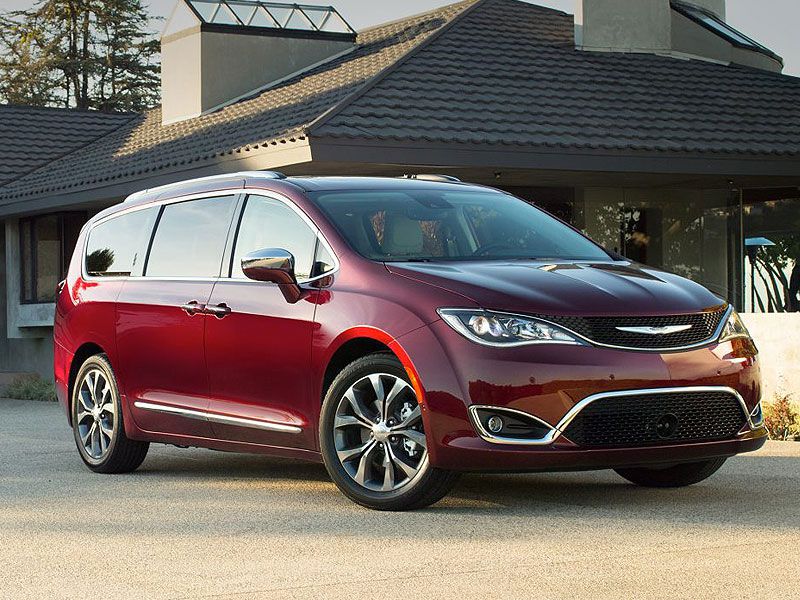
2017 Chrysler Pacifica exterior in driveway ・ Photo by Fiat Chrysler Automobiles
Meet the Pacifica, the latest iteration of Chrysler’s minivans and a vehicle that shows a lot of progress compared to its predecessor, the Chrysler Town & Country. Yeah, yeah, we know—not a lot of people love minivans, but the Pacifica might be able to change your mind.
Confessions of a Minivan Lover
Let me begin by stating for the record that I love minivans, particularly Chrysler minivans. When my own family began to grow, we bought a gently used Plymouth Voyager. I loved it (as I think most family men do; after all, what is the minivan but a sign of virility? “Look, world, my plumbing works so well that I had to buy a van for all my offspring!”) and while my wife-at-the-time didn’t like the mommymobile image, she grudgingly admitted that no other vehicle was as useful as a family car (and remember, being married to an automotive journalist, she’d tried all of them). So I’m biased toward liking Chrysler’s new 2017 Pacifica. Other manufacturers are trying to sneak away from the whole minivan thing, either shaping them like SUVs or referring to them as “MPVs” (which is Euro-speak for minivan). Not Chrysler: The Pacifica is unapologetic in its vanliness, and I appreciate its inherent honesty.
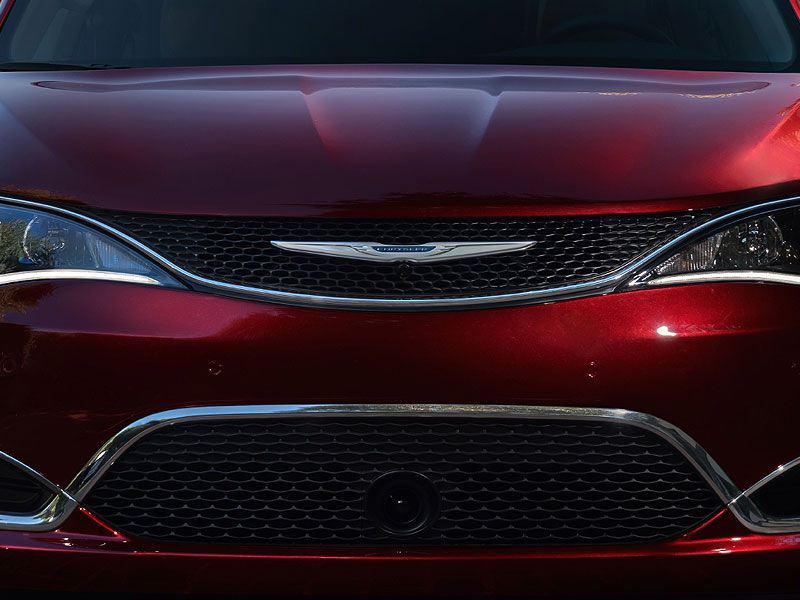
Photo by Fiat Chrysler Automobiles
If You Can’t Beat'em, Be More Posh Than Them
Chrysler ruled the van roost from the mid-1980s until around 2008, when the last Chrysler vans (Dodge Grand Caravan and Chrysler Town & Country) were introduced. By then, the Japanese (specifically Honda and Toyota) had become the minivan innovators, and Chrysler was coming up short. For this round, Chrysler gave up on trying to out-gadget their competitors, and has concentrated instead on building the nicest van possible. It starts with the dashboard, a soothing design with gently rounded shapes and soft-touch surfaces. Back when the previous-gen minivans were introduced, Chrysler was building some of the worst interiors in the business, but the new Pacifica is the complete opposite: Everything you see and touch, from the gentle blue lighting of the gauges to the softly damped buttons, seems designed to sooth the frazzled nerves of parents. Chrysler offers several different interior color schemes, making it easy to find a Pacifica that will take you to your happy place.
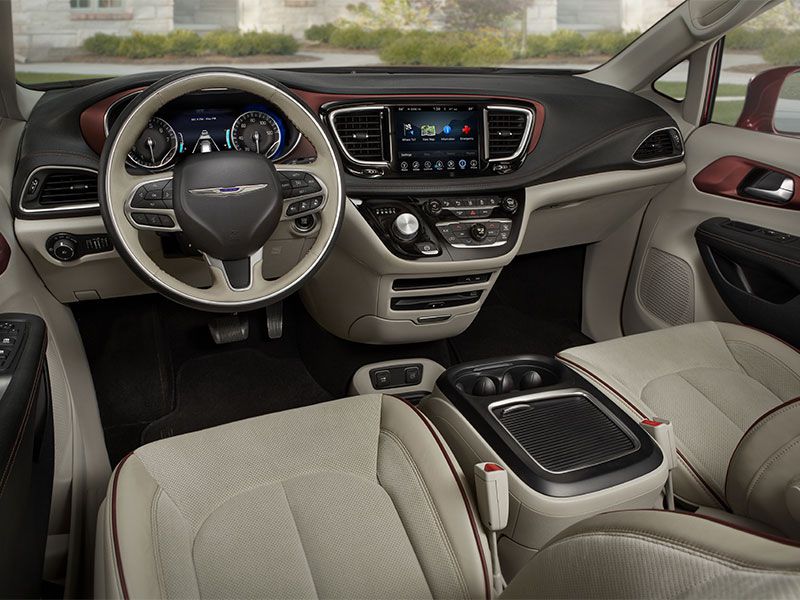
Photo by Fiat Chrysler Automobiles
Good Control Layout… Mostly
Chrysler’s UConnect stereo and navigation system is one of my favorites; the graphics are big and bright, and the menu system is easy to figure out. Chrysler has integrated many of the Pacifica’s systems into UConnect, including climate control, though you can still perform most functions using buttons on the dash. But the system does have its flaws: Seat heaters, for example, can only be controlled by the touchscreen; there are no dashboard buttons, and it’s annoying to have to page through menus on the screen just to warm your caboose, especially when that same screen is providing turn-by-turn directions. I became quite fond of the rotary-style shifter once I got used to it; ditto the pushbutton parking brake just beneath it (which automatically releases when you put the van in Drive and hit the gas). Simplifying the controls frees up lots of space for storage, and the Pacifica is awash in bins and cubbies, some covered, some not.
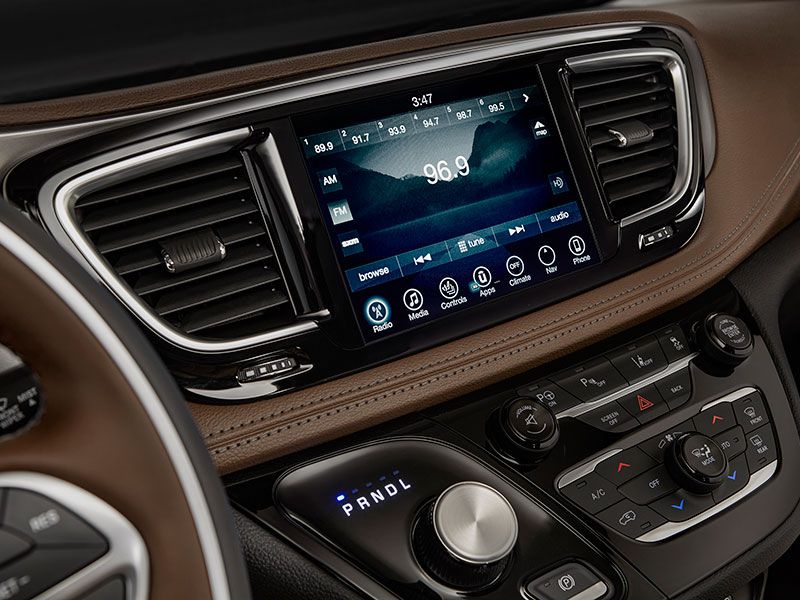
Photo by Fiat Chrysler Automobiles
Easy Access
Let’s move back to the second row, which is accessed through two sliding doors (a perfect solution for kids who are prone to flinging car doors open without regard; my own son did that just last week, and only by dint of my crooked parking job did he miss making a door ding that would have cost him about half a year's worth of allowance to fix). Power-operated sliding doors are nothing new, but Chrysler has integrated the “hands free” system used by many SUVs for their tailgates: Just kick your foot under the van and (provided the key fob is on your person) the doors will open.
Another reason I love minivans: While SUVs require parents to load their kids from the outside, a minivan allows you to get in with the kids, close the doors, and then get everyone buckled into their cars seats—a boon in both cold weather and dark, dodgy parking lots.
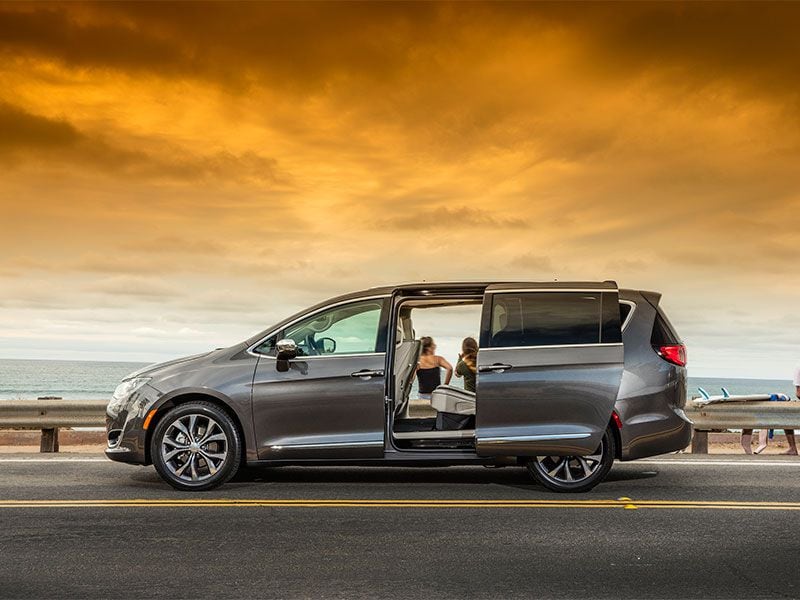
Photo by Fiat Chrysler Automobiles
Stow 'n Go: Handy, But There's a Trade-off
When the last Chrysler minivans were introduced, their most notable feature was the “Stow 'n Go” second-row seats, which could be folded down into storage compartments in the floor. Though I liked the concept, I was never a huge fan of these seats; I thought they were too small to provide proper support. The new generation of Stow 'n Go seats is definitely improved; The seats feel larger and more comfortable. Folding them is easy, too: Motor the front seats forward (there’s a button accessible from the second row to do this), then lift up the hinged lid in the floor. One lever drops the seat back and another clearly labeled strap releases the seat from its mounting points. A hidden arrangement of springs makes it easy to flop the seat down into its storage compartment. Drop the lid, and presto, the seat has disappeared. While the novelty is nice, I’m not entirely sold: How often do minivanners take out all the seats and use their vans as cargo haulers? Other vans have fixed buckets that are more comfortable, and I’d happily trade the stowing functionality for a better seat. That said, I do love those underfloor storage compartments: They are a great place to hide kids' electronics, and their tough plastic lining makes them a good receptable for sandy beach toys or muddy boots.
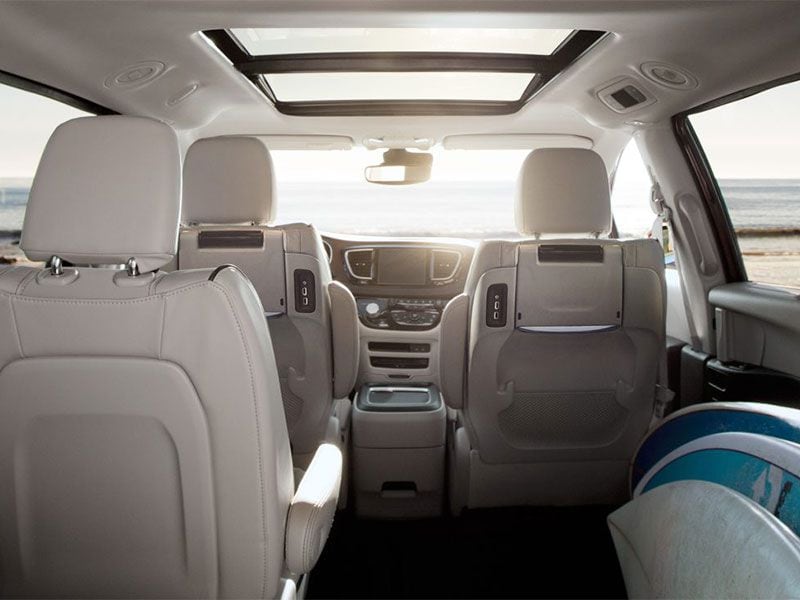
Photo by Fiat Chrysler Automobiles
Theater Seating
Most vans (and many SUVs) offer a rear-seat entertainment system, but Chrysler’s UConnect Theater may well beat them all. Each seat gets its own folding screen, and along with a built-in BluRay/DVD player, the system has USB and HDMI input ports and a 115-volt power outlet driven by a heavy duty alternator. The system has built-in games, including Solitaire, the license plate game, and an “Are We There Yet?” app that shows trip time and distance remaining from the Pacifica’s navigation system. Incidentally, should you need seating for an eighth backside, Chrysler offers an optional second-row middle seat that mounts between the two buckets. It is removable, and the backrest folds down flat to form an armrest with cupholders.
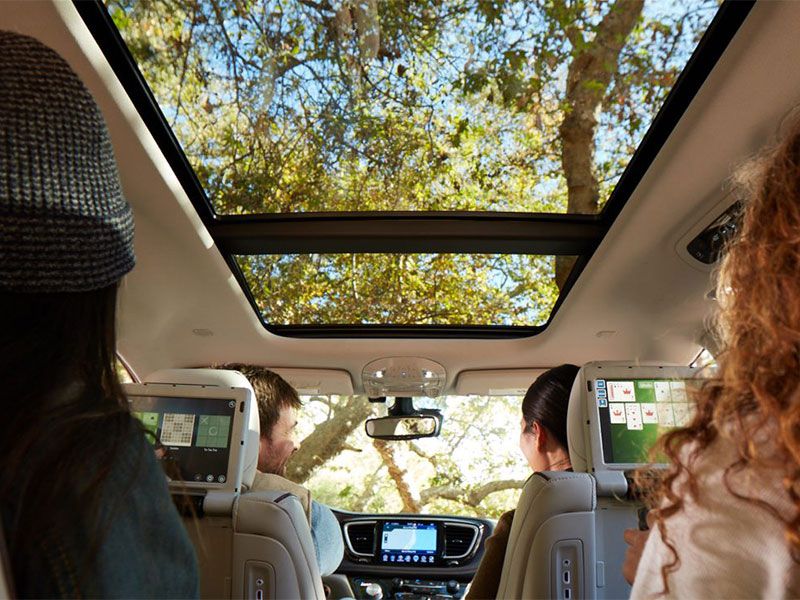
Photo by Fiat Chrysler Automobiles
Good Third Row: If You Can Live with the Angle
The third row separates minivans from three-row SUVs: While SUVs often have temporary perches, minivans have generous benches with room for adults. The Pacifica is no exception, though I’ve always found the upward angle of the seat-bottom a bit disconcerting, if not exactly uncomfortable. Chrysler has eased access with second-row seats that fold down and slide forward, and can do so even with a child seat installed. And speaking of child seats, the Pacifica has five—count'em, five!—sets of LATCH tethers. (For those unfamiliar, LATCH tethers are anchors for child seats that provide a more secure mounting than a traditional seat belt.) Quintuplets, anyone?
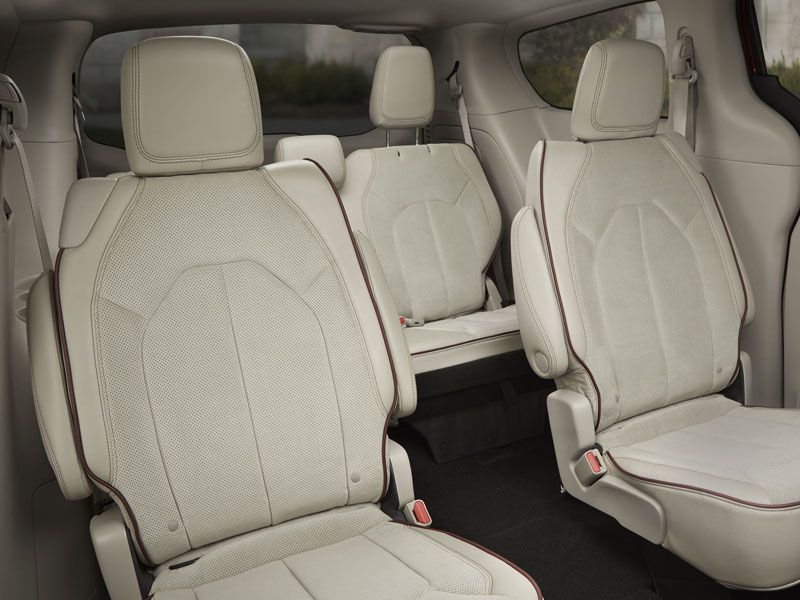
Photo by Fiat Chrysler Automobiles
Pack'em High
Another advantage to the minivan is the provision of luggage space behind the rear seats—32.3 cubic feet, to be exact, with a deep well that keeps items from shifting. When the third seat isn’t needed, it can be folded down into said well to provide a flat cargo floor. The Pacifica I tested had a power seat that could be stowed and deployed with buttons in the cargo area. My Pacifica also had a power liftgate, but the button to close it is on the interior, embedded in the window pillar, rather than on the tailgate as with most SUVs. I always felt I had to hit the button and the move quickly out of the tailgate’s way. (In truth, there’s adequate time to get out of the way before the tailgate starts to close, and it also can be closed via the key fob.)
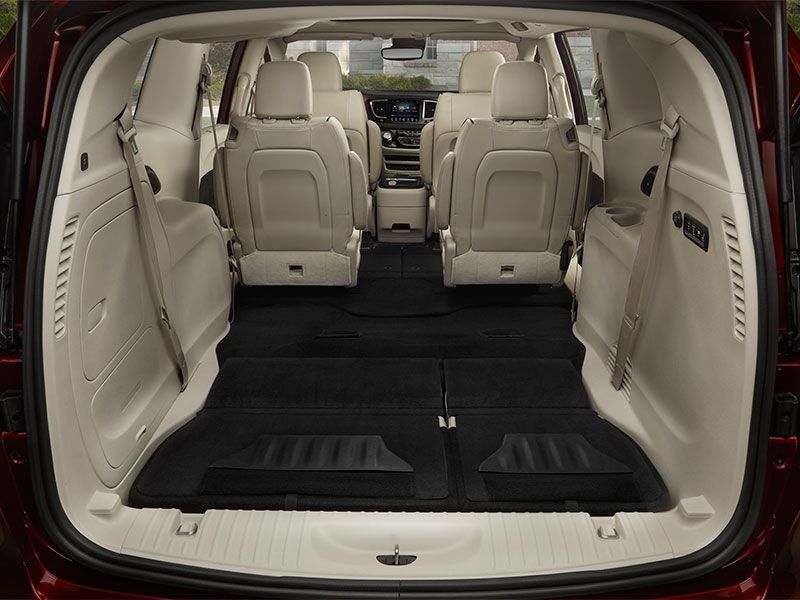
Photo by Fiat Chrysler Automobiles
On The Road
Out on the road, the Pacifica is an extraordinarily pleasant vehicle, with road manners that match its luxurious demeanor. Like many Chrysler products, the Pacifica uses a 3.6-liter V6 tuned for 287 horsepower. I’m a big fan of this engine: It’s very powerful, allowing the Pacifica to merge with authority and pass with ease, even with a load on board, and it produces full power with an aggressive snarl that belies its mommymobile image. The Pacifica can even tow a trailer, up to 3600 lb. The EPA rates the Pacifica at 18 mpg city/28 mpg highway/22 mpg combined, and during my test week I averaged 21.4 mpg. Chrysler pairs this engine with its 9-speed transmission, and while this transmission has garnered some criticism, it behaved beautifully in the Pacifica I drove, upshifting smoothly and downshifting promptly. The suspension is tuned for a quiet, serene ride, and accurate steering helps the Pacifica respond nicely in emergency movements.
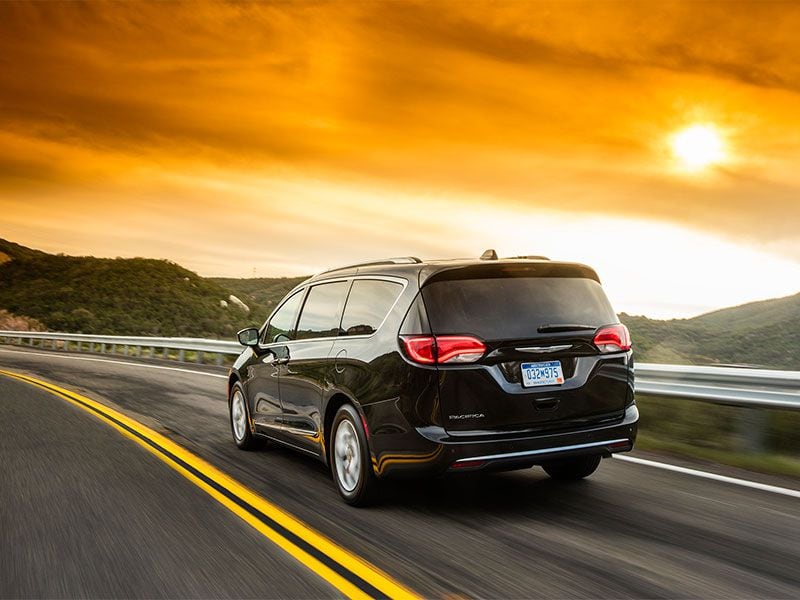
Photo by Fiat Chrysler Automobiles
It Needs a Better Gear Selector
My one complaint: There is no manual gear selection mode. The rotary shifter only has P-R-N-D-L positions, and L never selects a gear low enough to keep the Pacifica’s speed in check on California’s steep hills. That means the driver has to rely on the brakes, which can create a safety hazard—on a long, windy downgrade, riding the brakes can overheat them and reduce their efficiency. And if that happened in a Pacifica full of kids… well, I shudder to think of the possible consequences. As a safety measure, Chrysler should fit paddle shifters to the Pacifica, or a second lower-gear selection ASAP.
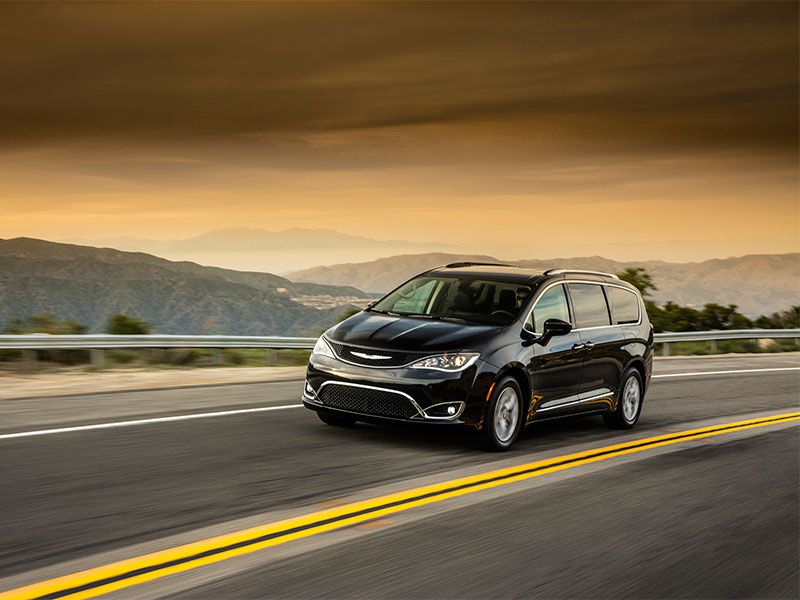
Photo by Fiat Chrysler Automobiles